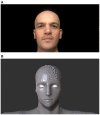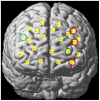An Exploratory Analysis of the Neural Correlates of Human-Robot Interactions With Functional Near Infrared Spectroscopy
- PMID: 35923750
- PMCID: PMC9339604
- DOI: 10.3389/fnhum.2022.883905
An Exploratory Analysis of the Neural Correlates of Human-Robot Interactions With Functional Near Infrared Spectroscopy
Abstract
Functional near infrared spectroscopy (fNIRS) has been gaining increasing interest as a practical mobile functional brain imaging technology for understanding the neural correlates of social cognition and emotional processing in the human prefrontal cortex (PFC). Considering the cognitive complexity of human-robot interactions, the aim of this study was to explore the neural correlates of emotional processing of congruent and incongruent pairs of human and robot audio-visual stimuli in the human PFC with fNIRS methodology. Hemodynamic responses from the PFC region of 29 subjects were recorded with fNIRS during an experimental paradigm which consisted of auditory and visual presentation of human and robot stimuli. Distinct neural responses to human and robot stimuli were detected at the dorsolateral prefrontal cortex (DLPFC) and orbitofrontal cortex (OFC) regions. Presentation of robot voice elicited significantly less hemodynamic response than presentation of human voice in a left OFC channel. Meanwhile, processing of human faces elicited significantly higher hemodynamic activity when compared to processing of robot faces in two left DLPFC channels and a left OFC channel. Significant correlation between the hemodynamic and behavioral responses for the face-voice mismatch effect was found in the left OFC. Our results highlight the potential of fNIRS for unraveling the neural processing of human and robot audio-visual stimuli, which might enable optimization of social robot designs and contribute to elucidation of the neural processing of human and robot stimuli in the PFC in naturalistic conditions.
Keywords: face-voice matching; functional near infrared spectroscopy (fNIRS); hemodynamic; human-robot interaction; prefrontal cortex.
Copyright © 2022 Yorgancigil, Yildirim, Urgen and Erdogan.
Conflict of interest statement
The authors declare that the research was conducted in the absence of any commercial or financial relationships that could be construed as a potential conflict of interest.
Figures







Similar articles
-
The effect of sensory manipulation on the static balance control and prefrontal cortex activation in older adults with mild cognitive impairment: a functional near-infrared spectroscopy (fNIRS) study.BMC Geriatr. 2024 Dec 19;24(1):1020. doi: 10.1186/s12877-024-05624-8. BMC Geriatr. 2024. PMID: 39702053 Free PMC article.
-
Young children with autism show atypical prefrontal cortical responses to humanoid robots: An fNIRS study.Int J Psychophysiol. 2022 Nov;181:23-32. doi: 10.1016/j.ijpsycho.2022.08.008. Epub 2022 Aug 28. Int J Psychophysiol. 2022. PMID: 36037937
-
Prefrontal functional connectivity measured with near-infrared spectroscopy during smoking cue exposure.Addict Biol. 2017 Mar;22(2):513-522. doi: 10.1111/adb.12344. Epub 2015 Dec 21. Addict Biol. 2017. PMID: 26687485
-
Near-Infrared Spectroscopy: A Free-Living Neuroscience Tool to Better Understand Diabetes and Obesity.Metabolites. 2023 Jul 3;13(7):814. doi: 10.3390/metabo13070814. Metabolites. 2023. PMID: 37512521 Free PMC article. Review.
-
Would life be better as a robot?Sci Robot. 2023 Dec 20;8(85):eadn0643. doi: 10.1126/scirobotics.adn0643. Epub 2023 Dec 20. Sci Robot. 2023. PMID: 38117870 Review.
Cited by
-
Interdisciplinary views of fNIRS: Current advancements, equity challenges, and an agenda for future needs of a diverse fNIRS research community.Front Integr Neurosci. 2023 Feb 27;17:1059679. doi: 10.3389/fnint.2023.1059679. eCollection 2023. Front Integr Neurosci. 2023. PMID: 36922983 Free PMC article. Review.
-
Neuroplasticity of Speech-in-Noise Processing in Older Adults Assessed by Functional Near-Infrared Spectroscopy (fNIRS).Brain Topogr. 2024 Nov;37(6):1139-1157. doi: 10.1007/s10548-024-01070-2. Epub 2024 Jul 23. Brain Topogr. 2024. PMID: 39042322 Free PMC article.
References
-
- Appel M., Izydorczyk D., Weber S., Mara M., Lischetzke T. (2020). The uncanny of mind in a machine: humanoid robots as tools, agents, and experiencers. Comput. Human Behav. 102, 274–286. 10.1016/j.chb.2019.07.031 - DOI
LinkOut - more resources
Full Text Sources
Miscellaneous

